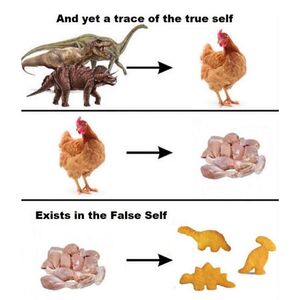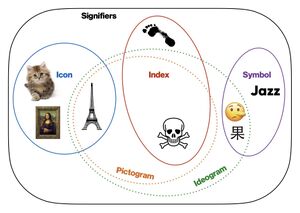Difference between revisions of "Sept 9"
Jump to navigation
Jump to search
| Line 2: | Line 2: | ||
[[File:Signifiers.jpg|thumb|Kinds of Signifiers]] | [[File:Signifiers.jpg|thumb|Kinds of Signifiers]] | ||
| + | |||
| + | '''Sept 9 Schedule for [[Uncreative Designing]]''' | ||
{| class="wikitable" | {| class="wikitable" | ||
| − | |||
| − | |||
|- | |- | ||
| 3:00 || Class Performance & Critique of new objects | | 3:00 || Class Performance & Critique of new objects | ||
| Line 16: | Line 16: | ||
| 6:00 || Use the remaining time to make static two-dimensional representations of each of your objects. | | 6:00 || Use the remaining time to make static two-dimensional representations of each of your objects. | ||
|} | |} | ||
| + | |||
| + | |||
| + | |||
'''Readings for Today:''' | '''Readings for Today:''' | ||
| Line 22: | Line 25: | ||
*Byung-Chul Han 한병철 複製 Fuzhi: Copy from Shanzhai | *Byung-Chul Han 한병철 複製 Fuzhi: Copy from Shanzhai | ||
| − | |||
| − | |||
| − | |||
| − | + | '''Semiotics Lexicon:''' | |
| − | + | {| class="wikitable sortable" | |
| − | + | |- | |
| − | + | ! | |
| − | + | |- | |
| − | + | | Signifier || a sign's physical form (such as a sound, printed word, or image) as distinct from its meaning. Compare with signified, referent. | |
| − | + | |- | |
| − | + | | Signified || the meaning or idea expressed by a sign, as distinct from the physical form in which it is expressed. Compare with signifier, referent. | |
| − | + | |- | |
| + | | Referent || the thing that a word or phrase denotes or stands for: “the Morning Star” and “the Evening Star” have the same referent (the planet Venus). Compare with signifier, signified. | ||
| + | |- | ||
| + | | Icon || a signifier that physically resembles the thing it represents. Compare with index, symbol. e.g., ☎ | ||
| + | |- | ||
| + | | Index|| a signifier with a direct link to what it represents. Compare with icon, symbol. e.g., ☠, ⌛ | ||
| + | |- | ||
| + | | Symbol || an arbitrary signifier with no resemblance or link to what it represents. The meaning of a symbol must be learned. Compare with icon, index. e.g., ☮, ☣ | ||
| + | |- | ||
| + | | Morpheme || the smallest meaningful lexical item in a language. "Unbreakable" is composed of three morphemes: un- (a bound morpheme signifying "not"), break (the root, a free morpheme), and -able (a bound morpheme signifying "an ability to be done"). | ||
| + | |- | ||
| + | | Ideogram || a written character symbolizing the idea of a thing without indicating the sounds used to say it. e.g., 42 and 果. | ||
| + | |- | ||
| + | | Pictogram/Pictograph || a pictorial symbol for a word or phrase. e.g. hirogliphics, ☺ | ||
| + | |- | ||
| + | | Logogram || a sign or character representing a word or phrase, such as those used in shorthand and some writing systems. e.g. &, $, % | ||
| + | |- | ||
| + | | Lorum || Lorum | ||
| + | |- | ||
| + | | Lorum || Lorum | ||
| + | |} | ||
Revision as of 17:59, 9 September 2022
Sept 9 Schedule for Uncreative Designing
| 3:00 | Class Performance & Critique of new objects |
| 4:20 | Break |
| 4:30 | Semiotics Lecture & Object Sorting |
| 5:20 | Discussion of The Terrifying Beauty of Absence |
| 6:00 | Use the remaining time to make static two-dimensional representations of each of your objects. |
Readings for Today:
- Alexander D'Hooghe The Terrifying Beauty of Absence
- This might be one of the best essays I've read in my entire life.
- Byung-Chul Han 한병철 複製 Fuzhi: Copy from Shanzhai
Semiotics Lexicon:
| Signifier | a sign's physical form (such as a sound, printed word, or image) as distinct from its meaning. Compare with signified, referent. |
| Signified | the meaning or idea expressed by a sign, as distinct from the physical form in which it is expressed. Compare with signifier, referent. |
| Referent | the thing that a word or phrase denotes or stands for: “the Morning Star” and “the Evening Star” have the same referent (the planet Venus). Compare with signifier, signified. |
| Icon | a signifier that physically resembles the thing it represents. Compare with index, symbol. e.g., ☎ |
| Index | a signifier with a direct link to what it represents. Compare with icon, symbol. e.g., ☠, ⌛ |
| Symbol | an arbitrary signifier with no resemblance or link to what it represents. The meaning of a symbol must be learned. Compare with icon, index. e.g., ☮, ☣ |
| Morpheme | the smallest meaningful lexical item in a language. "Unbreakable" is composed of three morphemes: un- (a bound morpheme signifying "not"), break (the root, a free morpheme), and -able (a bound morpheme signifying "an ability to be done"). |
| Ideogram | a written character symbolizing the idea of a thing without indicating the sounds used to say it. e.g., 42 and 果. |
| Pictogram/Pictograph | a pictorial symbol for a word or phrase. e.g. hirogliphics, ☺ |
| Logogram | a sign or character representing a word or phrase, such as those used in shorthand and some writing systems. e.g. &, $, % |
| Lorum | Lorum |
| Lorum | Lorum |

